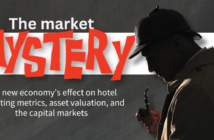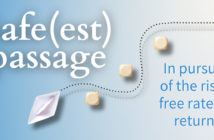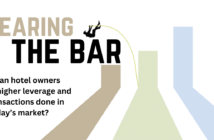How non-recourse CMBS lenders determine your maximum loan amount.
By Rushi Shah
For bank and other recourse loans that require personal guarantees, both the borrower’s and the property’s ability to pay back the loan are evaluated.
Non-recourse loans from lenders who pool their loans into bonds for investors to buy on the secondary market (which translates into lower interest rates and longer term fixed rate for borrowers), however they require that the property alone be able to sustain the loan payments or be sold at an expected value in the case of borrower default.
It is wise to know what metrics influence a lender’s decision-making process to ensure your hotel is assessed accurately and that you receive the maximum proceeds possible at the market’s best available rates and terms.
RevPar index
Before a loan amount is calculated, lenders will confirm that your property is performing at or above your peer group by multiplying your hotel’s average daily rate by its percent occupancy and comparing it to the competition on the STR report. Known as the RevPar Index, lenders use this metric as a barometer of how well the hotel is managed and look for an index closer to 100 percent.
A RevPar Index lower than 100 percent warrants a well-constructed explanation from your intermediary before the deal gets presented to an investor’s credit committee. Your intermediary should confirm that the competitive set of your hotel is valid and not stacked to artificially “juice up” the RevPar Index.
Net cash flow
Net cash flow (NCF) – also known as net operating income or NOI – is the owner’s net profit before paying for any debt (i.e., interest and principal) or any non-cash expenses (i.e., depreciation or amortization). Used to both value the hotel and determine the loan amount, NCF is calculated by subtracting expenses (including a typical 3-percent management fee) and any reserves (such as a 4-percent reserve for FF&E) from your property’s last 12 months of revenue (lenders may look at last three years).
For example, a 90-room Hampton Inn located in a second- or third-tier market with $3,000,000 in revenue should have a NCF of about $1,050,000 or 35 percent of revenue.
Your intermediary’s ability to understand and scrub your P&L and other financials in order to uncover one-time expenses and capital expenditures that can be credited back to you to improve your NOI, is critical, as a higher NCF number results in a higher loan amount. Even if two properties have the same NCF, they may not qualify for the same loan amount, as market conditions, flag, property condition, location, operating efficiencies, remaining franchise term, and costs to build, buy or renovate the asset will differ.
Capitalization rates
To help determine your hotel’s value – or the percent return an investor would receive if someone bought the property for cash – lenders divide NOI by the hotel’s estimated value (based on sales of peers in the same market) to arrive at a capitalization or cap rate. The lower the cap rate, the higher the hotel’s value. The maximum LTV allowed by the lender is applied to the calculated value to determine the loan amount. Cap rates in markets with few trades can vary widely, so make sure whomever represents you has the market knowledge to address any anomalies.
In the case of our example, based on the market’s past sales data, the hotel should be valued at a 7.5 percent cap rate, and the estimated theoretical value of the hotel for financing would be $14,000,000.
Debt yield and LTV requirements
NOI is divided by the proposed loan amount to determine what the expected rate of return on a lender’s investment would be on day one, or its debt yield. When income is less predictable, as in markets where cash flow is less stable or for flags lower on the STR chain scale, lenders raise their required debt yield level, which lowers maximum proceeds.
Typical targets range from 9 percent in primary markets for higher-end hotels, to 10 percent to 12 percent in secondary and tertiary markets for select-service hotels.
Bottom line, the lower the debt-yield requirement, the higher the loan amount. Your final loan amount, however, is still subject to the lender’s loan-to-value (LTV) cap, which is usually 70 percent for select-service hotels. Debt yield and LTV are the main drivers for leverage. As credit markets pull back on hotel lending, debt yield often rises and LTVs drop.
With an NCF of $1,050,000, our example’s $14,000,000 estimated value and Debt Yield of 11 percent will garner a maximum loan amount of $9,500,000.
Total cost basis in the property
Often ignored by inexperienced brokers, but important to credit committees and rating agencies that govern the bond markets, is a property’s total cost basis or the total dollars invested for construction or capital improvements since the hotel was built or acquired. This is especially critical for a cash out refinance as the new loan will be significantly higher than your current loan. The longer you’ve owned the property, the less important this factor becomes.
If the example hotel was built for $8,000,000 15 years ago, a $9,500,000 loan should be possible. If built for the same price but only one year ago, then the loan amount may be out of reach unless your intermediary can successfully demonstrate mitigating factors to the lender.
To better prepare you and your property for your financing, search and ensure you don’t leave money on the table, do the math upfront. Leveraging the expertise of an experienced intermediary who knows your market, knows the industry, who is actively closing deals and has a strong relationship with the lender, will improve your final result. ■
Rushi Shah is an executive vice president at commercial mortgage banking firm Aries Capital, LLC, and president of its online non‑recourse platform LendingCap Commercial. Since 1991, Aries has arranged/funded over $5 billion in financing in the U.S. and Caribbean. Shah held previous positions at Northern Trust. A member of AAHOA’s Founding & Allied Member Committee, Shah holds an MBA from The University of Chicago’s Booth School of Business.




